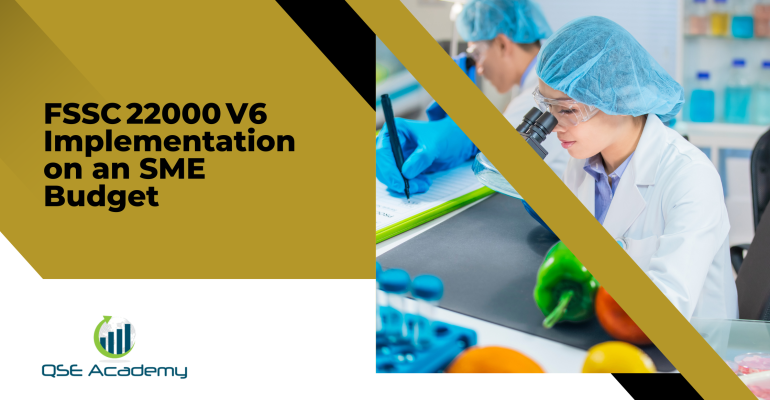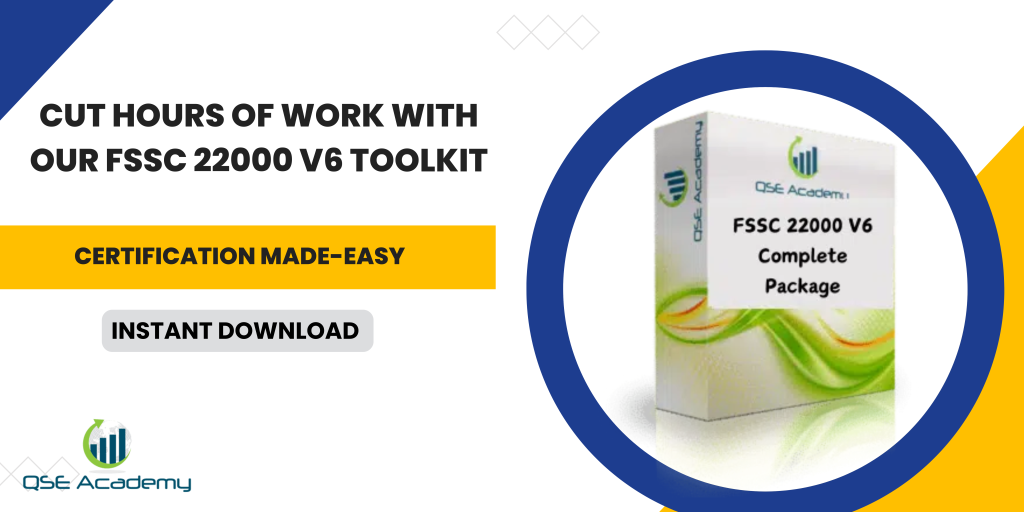FSSC 22000 V6 Implementation on an SME Budget
Making FSSC 22000 V6 Affordable and Practical
Let’s be honest—many small and medium-sized food businesses want to get certified but worry about cost. Between consultants, auditors, and documentation, the process can sound expensive and overwhelming.
But here’s what I’ve seen over the years working with SMEs across Asia, Africa, and the Middle East: you don’t need a huge budget to build a compliant food-safety system.
You just need a smart plan.
At QSE Academy, we’ve helped small bakeries, family-owned producers, and local packaging companies achieve FSSC 22000 certification without overspending. This guide shows you how to do the same—step-by-step, using what you already have.
You’ll learn how to:
- Understand where the real costs come from.
- Build a realistic plan that fits your resources.
- Use practical tools, templates, and free platforms to keep costs down.
Let’s make FSSC 22000 achievable—no big budget required.
Understanding Where the Real Costs Come From
The first step in saving money is knowing where it actually goes.
When SMEs reach out to us, they often assume certification costs are all about the audit. But the audit is just one piece. The bigger costs usually come from:
- Consulting or internal manpower: Who’s writing your documents, training staff, and preparing for audits?
- Documentation and training: Creating procedures, manuals, and awareness sessions.
- Infrastructure upgrades: Sometimes minor facility improvements are needed to meet PRP standards.
- Certification body fees: Depending on your size and scope, these are typically 25–35% of total cost.
Here’s the good news: not all of these need big spending.
You can build internal capacity, use pre-made templates, and plan upgrades gradually.
Common Mistake: Thinking certification requires a full digital overhaul right away. Focus first on compliance and clarity—automation can come later.
 Step-by-Step: How to Implement FSSC 22000 V6 Efficiently
Step-by-Step: How to Implement FSSC 22000 V6 Efficiently
Implementing on a tight budget means working smart, not fast. Here’s a roadmap that actually works for small companies.
Step 1 – Start with a Gap Analysis
This is your baseline. Compare your current practices against ISO 22000:2018, ISO/TS 22002-x PRPs, and the FSSC V6 additional requirements.
You’ll see exactly what’s missing—and what’s already compliant.
Pro Tip: You can complete this in a week using QSE Academy’s Gap-Analysis Checklist and your internal Food-Safety Team.
Step 2 – Build a Lean Project Plan
You don’t need a massive Gantt chart. Just list milestones: gap analysis, documentation, training, internal audit, and certification.
Assign one owner per phase—small teams work better with clear accountability.
Step 3 – Use Pre-Made Documentation Packages
Writing every document from scratch drains both time and money.
Instead, adapt ready-to-use templates that already align with FSSC 22000 V6.
Common Mistake: Hiring expensive consultants to write procedures you could easily customize internally. Templates let you focus on implementation, not wordsmithing.
Step 4 – Train Internally
Nominate a Food-Safety Team Leader and deliver short, focused training sessions. You don’t need off-site workshops—use remote webinars or internal sessions.
Pro Tip: QSE Academy offers short, affordable e-learning modules you can re-use for onboarding.
Step 5 – Prepare for the Audit
Schedule your internal audit and management review well before the certification audit.
Use mock audits to fix small issues early—these cost nothing but save you a lot later.
Smart Ways to Cut Costs Without Cutting Quality
You can save a lot without compromising compliance. Here’s how:
- Leverage your people. Promote from within—train your QA Supervisor as your Food-Safety Team Leader.
- Use low-cost tools. Google Drive for document control, Trello for tracking, or Excel for records.
- Combine audits. If you’re already ISO 9001 certified, bundle it with FSSC 22000. Most certification bodies offer discounts for combined audits.
- Collaborate. Partner with suppliers or local associations for shared PRP training sessions.
- Invest in training—not consultants. Skills stay in-house, saving money long term.
Pro Tip: The smartest spending is on knowledge. Once your team understands the system, external support becomes optional.
Common Pitfall: Outsourcing every step. It feels easier but builds dependency—and costs more year after year.
Real-World Example — How a Small Food Business Did It
One of our clients, a small snack manufacturer in the Philippines, started with a tight budget—just three core staff and limited resources.
They used QSE Academy’s documentation toolkit, conducted their gap analysis in-house, and completed online training modules for their Food-Safety Team.
No fancy software. No full-time consultant.
Six months later, they passed their FSSC 22000 V6 audit on the first try—with only two minor nonconformities.
Their secret? Consistency and teamwork. They didn’t spend more—they just spent wisely.
Funding and Support Options for SMEs
Many businesses don’t realize there’s help available.
- Government grants or food-industry programs: Some countries subsidize certification costs for SMEs to boost export readiness.
- Retailer or supplier programs: Large buyers often co-fund supplier certification to strengthen their chain.
- Certification bodies: Some offer payment plans or pre-assessment discounts for small firms.
Pro Tip: Don’t hesitate to ask. Certification bodies and local trade agencies are often open to negotiation or phased payments.
FAQs — Addressing Common Concerns
Q1. How much does FSSC 22000 certification typically cost for an SME?
Most small companies spend USD 3,000–8,000 total, including documentation, training, and certification fees.
Q2. Can we implement without hiring consultants?
Absolutely. Many SMEs succeed using editable templates, internal leaders, and online coaching.
Q3. What’s the fastest way to start on a limited budget?
Start with a gap analysis, then focus on documentation and training before scheduling any audit.
Conclusion — Food-Safety Compliance Doesn’t Require a Big Budget
FSSC 22000 V6 certification is completely achievable for small businesses—it just takes focus, structure, and commitment.
You don’t need to overspend to build a compliant, functional system.
At QSE Academy, we’ve seen dozens of SMEs transform their operations with the right tools and mindset—not by spending more, but by managing smarter.
If you’re ready to start, download QSE Academy’s “FSSC 22000 V6 SME Implementation Starter Kit.”
It includes editable templates, a simple action plan, and the guidance you need to make certification achievable—no matter your budget.
Melissa Lavaro is a seasoned ISO consultant and an enthusiastic advocate for quality management standards. With a rich experience in conducting audits and providing consultancy services, Melissa specializes in helping organizations implement and adapt to ISO standards. Her passion for quality management is evident in her hands-on approach and deep understanding of the regulatory frameworks. Melissa’s expertise and energetic commitment make her a sought-after consultant, dedicated to elevating organizational compliance and performance through practical, insightful guidance.








